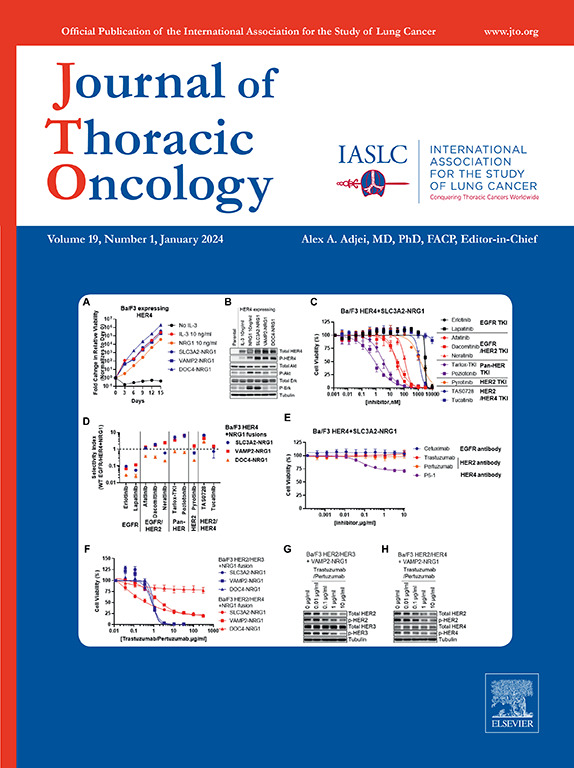Real-World Acute Toxicity and 90-Day Mortality in Patients With Stage I NSCLC Treated With Stereotactic Body Radiotherapy
IF 21
1区 医学
Q1 ONCOLOGY
引用次数: 0
Abstract
Introduction
Stereotactic body radiotherapy (SBRT) has firmly established its role in stage I NSCLC. Clinical trial results may not fully apply to real-world scenarios. This study aimed to uncover the real-world incidence of acute toxicity and 90-day mortality in patients with SBRT-treated stage I NSCLC and develop prediction models for these outcomes.
Methods
Prospective data from the Dutch Lung Cancer Audit for Radiotherapy (DLCA-R) were collected nationally. Patients with stage I NSCLC (cT1-2aN0M0) treated with SBRT in 2017 to 2021 were included. Acute toxicity was assessed, defined as grade greater than or equal to 2 radiation pneumonitis or grade greater than or equal to 3 non-hematologic toxicity less than or equal to 90 days after SBRT. Prediction models for acute toxicity and 90-day mortality were developed and internally validated.
Results
Among 7279 patients, the mean age was 72.5 years, with 21.6% being above 80 years. Most were male (50.7%), had WHO scores 0 to 1 (73.3%), and had cT1a-b tumors (64.6%), predominantly in the upper lobes (65.2%). Acute toxicity was observed in 280 (3.8%) of patients and 90-day mortality in 122 (1.7%). Predictors for acute toxicity included WHO greater than or equal to 2, lower forced expiratory volume in 1 second and diffusion capacity for carbon monoxide, no pathology confirmation, middle or lower lobe tumor location, cT1c-cT2a stage, and higher mean lung dose (c-statistic 0.68). Male sex, WHO greater than or equal to 2, and acute toxicity predicted higher 90-day mortality (c-statistic 0.73).
Conclusions
This nationwide study revealed a low rate of acute toxicity and an acceptable 90-day mortality rate in patients with SBRT-treated stage I NSCLC. Notably, advanced age did not increase acute toxicity or mortality risk. Our predictive models, with satisfactory performance, offer valuable tools for identifying high-risk patients.
接受立体定向体放射治疗的 I 期非小细胞肺癌患者的真实急性毒性和 90 天死亡率。
简介:立体定向体放射治疗(SBRT立体定向体放射治疗(SBRT)已在 I 期非小细胞肺癌(NSCLC)中发挥了重要作用。临床试验结果可能并不完全适用于实际情况。本研究旨在揭示SBRT治疗的I期NSCLC患者在现实世界中的急性毒性和90天死亡率,并为这些结果建立预测模型:方法:从荷兰肺癌放疗审计(DLCA-R)中收集全国性的前瞻性数据。纳入了2017-2021年接受SBRT治疗的I期NSCLC(cT1-2aN0M0)患者。对急性毒性进行了评估,急性毒性定义为 SBRT 后≤90 天的≥2 级放射性肺炎或≥3 级非血液学毒性。建立了急性毒性和90天死亡率的预测模型,并进行了内部验证:在7279名患者中,平均年龄为72.5岁,21.6%的患者年龄大于80岁。大多数患者为女性(50.7%),WHO评分为0-1分(73.3%),cT1a-b肿瘤(64.6%),主要位于上叶(65.2%)。280名患者(3.8%)出现急性毒性,122名患者(1.7%)90天内死亡。急性毒性的预测因素包括 WHO ≥2、较低的 FEV1 和 DLCO、未经病理确认、中/下叶肿瘤位置、cT1c-cT2a 分期和较高的平均肺剂量(c 统计量为 0.68)。女性性别、WHO ≥2和急性毒性预示着较高的90天死亡率(c统计量为0.73):这项全国性研究显示,SBRT 治疗的 I 期 NSCLC 患者急性毒性发生率低,90 天死亡率可接受。值得注意的是,高龄并未增加急性毒性或死亡率风险。我们的预测模型性能令人满意,为识别高危患者提供了有价值的工具。
本文章由计算机程序翻译,如有差异,请以英文原文为准。
求助全文
约1分钟内获得全文
求助全文
来源期刊

Journal of Thoracic Oncology
医学-呼吸系统
CiteScore
36.00
自引率
3.90%
发文量
1406
审稿时长
13 days
期刊介绍:
Journal of Thoracic Oncology (JTO), the official journal of the International Association for the Study of Lung Cancer,is the primary educational and informational publication for topics relevant to the prevention, detection, diagnosis, and treatment of all thoracic malignancies.The readship includes epidemiologists, medical oncologists, radiation oncologists, thoracic surgeons, pulmonologists, radiologists, pathologists, nuclear medicine physicians, and research scientists with a special interest in thoracic oncology.
 求助内容:
求助内容: 应助结果提醒方式:
应助结果提醒方式:


